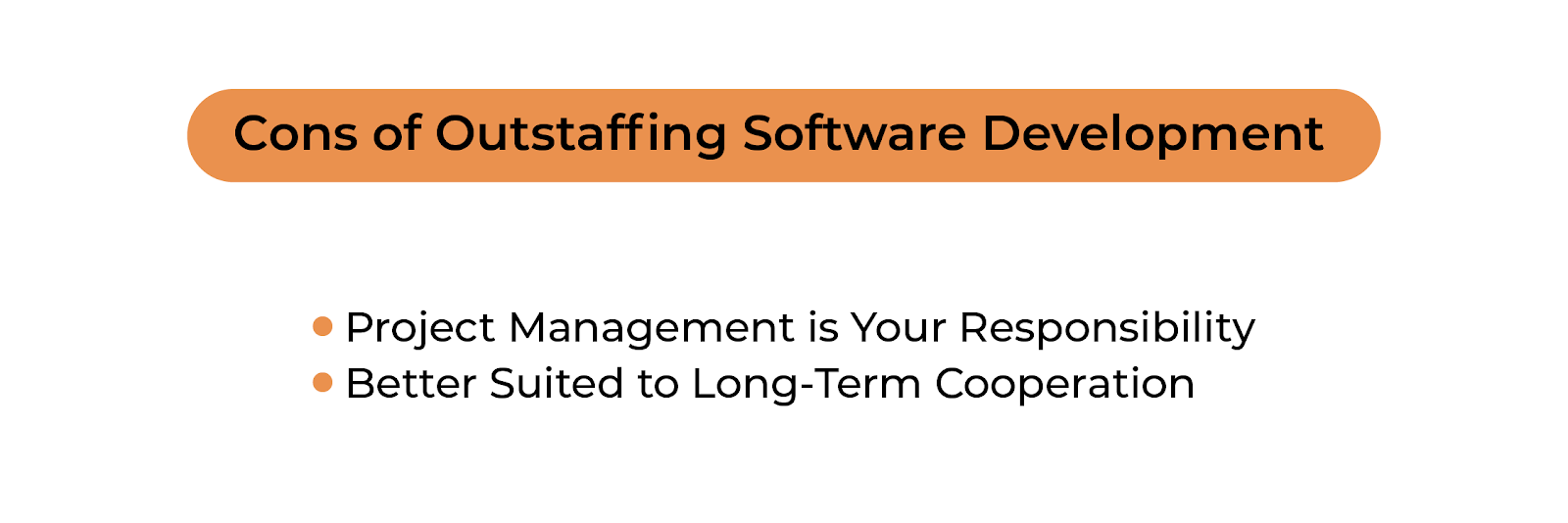
Outsourcing vs Outstaffing: What’s the Difference and Which Should You Choose?
As companies grow and expand, they may reach a point where it makes sense to hire remote experts over in-house professionals.
These can be remote employees, remote vendors, or even entire companies or boutique firms. Regardless of location, what matters is that the outsourced team provides high-quality services with good communication for less than a company could find locally.
Source: Grand View Research
However, there are two distinct types of remote IT service structures. They are known as outsourcing and outstaffing. In this article, we’ll examine each one, analyze the pros and cons, and help you identify which type of outsourcing companies will meet your software solutions needs.
What is an Outsourcing Model & How Does it Work?
There is quite a bit of bleed over in outsourcing vs outstaffing when it comes to software development services.
However, there are some stark differences in structure that can help you tell the difference between the two. Just keep in mind that we’re mostly talking about generalities here. Any deal you negotiate may end up differing slightly.
Quite simply: outsourcing providers are “project-based.”
That means a client company will entrust the outsourcing agency with an entire project, which they will then complete from A to Z.
In this case, the client will rarely have any interaction with the software development team.
Think of it as hiring a self-sufficient division that just so happens to not be down the hall from your office. Outsourcing vendors have the resources, equipment, and team required to get the job done. In most cases, clients can take a hands-off approach and simply wait for delivery from their remote employees.
Pros of Outsourcing Software Development
Cost Efficiency
Aside from the fact that outsourcing services generally come with a much lower cost due to remote and cheaper locations, you also need to realize that even dedicated teams work on an hourly-paid basis.
This means you, as the client, only pay for the time they spend working on a particular project. There are no “extra” bills for office supplies, equipment, etc. You pay for the development and nothing else.
The Vendor is Responsible for Code Quality
One of the things that worries clients attempting hands-off outsourcing is what will happen if the code simply doesn’t work? To them, it’s a bit like buying a product off the internet sight unseen with no possibility of getting a refund.
Well, there’s good news there, because the outsourcing vendor is responsible for handling all of the quality assurance. The development team will make sure the code is operational before it’s delivered.
No Management Efforts
This is a big benefit that appeals to many first-time IT outsourcers. You see, one of the vendor’s job duties is to provide you with a completely “turnkey service.”
That means they collect and manage all the resources necessary to complete the project, with their team, their equipment, and more. They also set up a timeline for deliverables, reports, and QA.
Wide Choice of Talent Experts
Over the years, the outsourcing industry has grown into a massive pool of global professionals and vendors with superior technical knowledge. These people and organizations all have varying levels of expertise (and costs that typically align with them).
So, if your company is looking for IT outsourcing in a particular area or at a particular cost, you pretty much have the pick of the litter.
Reliability and Speed
The IT industry is one of the most competitive in the world. While this presents huge money-making opportunities for companies of all sizes, it also means they need to get their product to market as soon as possible.
Outsourcing vendors understand this and are equipped to make delivery faster than most in-house teams. They also provide comprehensive project support throughout.
Innovative Solutions
IT outsourcing vendors are highly experienced in software development, which means they can take on a lot of project responsibility.
So, when they’re presented with a problem, they don’t come crying to you to figure out how best to solve it. Instead, they get the job done, usually in a very innovative way. These innovative technical solutions can prove invaluable to your business down the line.
Cons of Outsourcing Software Development
Limited Visibility
When you use your own team, figuring out what’s going on with the project is usually as simple as walking down the hall. This type of oversight is impossible to get from even the most collaborative outsourcing project.
So, if you’re the type of manager that needs loads of participation (or your project is extremely complex), outsourcing could get frustrating.
Risk of Miscommunication
If you’re familiar with the “telephone game,” you know how easy information can change as it moves from person to person. Now imagine that there’s a miscommunication barrier, and you’re dealing with people in remote locations.
While Zoom and other platforms have helped lessen this issue, many clients are still frustrated by having to repeat themselves during the development process.
More Expensive than Outstaffing Services
As mentioned, cost efficiency is indeed one of the pros of outsourcing business models. However, even the best price structure can’t compete with Outstaffing.
So, if your company is new, has limited software development budgets, or otherwise needs to do things “on the cheap,” hiring an outsourcing company might prove cost-prohibitive.
When to Consider Outsourcing
Established companies that are experienced at setting project parameters and who might even be able to provide a template or two generally do very well with an outsourcing model.
Smaller companies or those that are working on more innovative projects generally need business models with more hands-on management.
Owners with a non-technical background who don’t have experience managing IT projects. This issue especially addresses early startups.
But if the development process is likely to change, outsourcing can be a difficult solution.
Ultimately, if you work on a project-based business model, you’ll benefit most from this type of structure.
What is Outstaffing & How Does it Work?
Outstaffing is, for the most part, a form of outsourcing.
However, it differs in that you’re essentially hiring specific professionals or specialists for long-term projects, individual tasks, or as helping hands during busy periods.
And while they work directly for you, these professionals are officially employed by a third-party vendor who acts as remote managers or HR directors.
The best way to think of outstaffing vs outsourcing is to think of the former as another dedicated team member that just so happens to be working remotely. In fact, it could even be a full external team overseas.
Pros of Outstaffing Software Development
Flexible hiring model
Outstaffing is about as flexible as things get when you’re hiring third parties.
You can easily change the schedule of your software development team members, adjust their level of involvement, delegate primary tasks, and provide feedback.
However, all of the background stuff (payroll, HR, team maintenance) is handled by the vendor on your behalf.
Lower Costs
Since the client takes a more active part in managing the outstaffed team members, outstaffing models generally come with a much lower cost.
Essentially, you’re eliminating the hours’ vendors have to spend managing the project on your behalf (which can be some of the most expensive lines on the invoice).
They can also handle much of the hiring process, which simplifies your interaction and ensures skilled personnel.
Full Access and Control
Outstaffing services enable the client to take over all the project manager duties. Whereas outsourcing trends are all about paying for a “hands-off” approach, outstaffing puts you in the driver’s seat to ensure you get exactly the results you want.
So, if you have a particularly complicated project or one that you feel requires your direct oversight, an outstaffing company is the better option.
Free IT recruitment
The outstaffing model is a great way to bring on new talent, and free recruiting services can help you find exactly what your company needs.
Cons of Outstaffing Software Development
Project Management is Your Responsibility
Saying something like “managing the project is up to the client” sounds great to many business owners until it actually comes time to manage the project.
Sometimes, the sheer weight of the responsibility can be too much for a client who is managing the project along with their other duties.
Other times, communication channels between the vendor, client, and the remote software development team can simply get too muddled. Either way, it’s important to realize that this is a big job.
Better Suited to Long-Term Cooperation
Short-term projects are common in the outstaffing world. However, many clients have noticed that the model actually lends itself better to long-term collaboration. This is because it might take some time to get the communication where it needs to be.
If a client gives up on an outstaffing team member too early, they might have to “start from scratch” every time they need a project completed. This sort of full cycle software development can be a hindrance in some cases.
When to Consider Outstaffing
Outstaffing is ideal for companies that are working on newer, less established projects or who prefer to have more control over IT development.
Generally, businesses like this can’t get by with a “fire and forget” model like outsourcing and may even hinder the development of a long-term relationship by constantly trying to “co-manage” the entire process.
All in all, if you don’t feel comfortable giving a detailed assignment and simply waiting for the software development service provider to complete it, an outstaffing company is the better choice.
Which Solution is Best for You?
As you can see, outsourcing and outstaffing are just as similar as they are different. Moreover, neither one is a “magic bullet” that is sure to solve all of your IT development needs.
It’s always going to depend on what you’re looking to achieve (and how you want to achieve it).
To put it as plainly as possible: outsourcing is best for companies that aren’t looking to create an entire IT department from scratch but don’t feel the project requires their direct involvement.
Though outsourcing structures can be customized to fit a client company's needs, most outsourcing providers prefer to receive detailed instructions and then complete the tasks on their own.
Companies that have IT professionals in place, but fear overloading them with too much work, usually see a lot of benefits from an outstaffing structure to establish a remote software development team.
Though it requires much closer supervision and management, it’s very cost-effective and can eventually lead to a long-term relationship if both parties perform as expected. You can also form a bond with your outstaffing provider, which will make jobs easier in the future.
Ultimately, if you want your own remote employees, there is a solution for you.
Related articles

How AI Tools Are Transforming Development at Inventorsoft

IT Budget Planning 2026: How Tech Leaders Can Win in an Uncertain Year

The Discovery Phase of a Software Development Project: What It Is and Why You Need It
- What is an Outsourcing Model & How Does it Work?
- Pros of Outsourcing Software Development
- Cons of Outsourcing Software Development
- When to Consider Outsourcing
- What is Outstaffing & How Does it Work?
- Pros of Outstaffing Software Development
- Cons of Outstaffing Software Development
- When to Consider Outstaffing
- Which Solution is Best for You?
